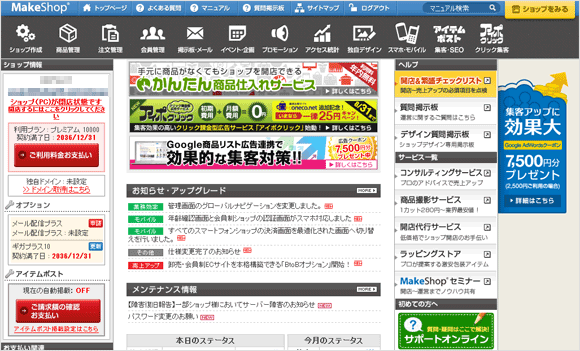Leading e-commerce platform Shopify has been on our radar for quite a while now, and we were very pleased when they announced new support for Japanese in their shop administration console. With that change, Shopify is finally ready to compete with the long list of existing hosted EC solutions on the market in Japan.
And compete it will. As anyone familiar with the many EC offerings available here can tell you, the local EC solutions suffer from some serious shortcomings. Specifically:
Design
In fairness, I haven’t inspected the latest version of every SaaS out there, and there’s a chance I’m overlooking some little-known gem. Over the years, however, I’ve seen a lot of these hosted e-commerce solutions, and without exception have found the user experience and design of their administration consoles to be woefully primitive and poorly conceived, exhibiting all the trademarks of Japanese web “design.”

I put design in quotes because this kind of design characteristically involves no design. It is the kind of user experience and design you get when you exclude talented UI and UX designers from the process and let the developers do whatever they think is best. The outcome in these situations is more often than not crap.
With Shopify, however, Japan has an EC platform that is well-designed, attractive, and intuitive. Better still, it’s completely responsive, and looks and works nice on any device. Oh, and they also have a great iOS app for managing your store on the go. Nice, eh? Thanks, Canada!
Extensibility
One other problem with most Japanese EC solutions (and much of the web here in general) is a lack of APIs. North America has known for years about the importance getting all those disparate systems talking to each other, and the best way to facilitate that is to develop a robust API for your web application. However, take a look at some of the biggest players out there and tell me what you find. Go ahead, I’ll wait.
In fact, the only ones I could find that offer and promote their API are BASE and Ebisumart. It boggles the mind, really, until you remember that you can always count on companies like GMO and other lumbering cyber-giants to stay steadfastly 10-20 years behind the curve when it comes to anything Internet-related.
Our guess? Shopify’s solid API, rich developer tools, and app marketplace will make the product far more competitive here as its integrations with other applications and web services explode. I can assure you we’ll be there to help. ;-)
Multilingual Support
Another area where Shopify stands out is in its ability to easily setup multilingual websites and online stores. In Japan today there is intense interest in 越境EC, or cross-border e-commerce, and some of the Japanese ASP offerings are responding by creating English- and Chinese-language versions of their customer-facing interfaces. The implementations are often clunky, and reply on Google Translate to render passable-but-not-pretty translations. However, using a multilingual app like Langify you can easily create and operate a multilingual store on Shopify. Go global, baby!
Shopify FTW!
We have developed a few Shopify websites to-date and I have to say: we love Shopify! For simpler e-commerce sites that don’t require a lot of specialized functionality or custom coding, Shopify can be an excellent and affordable choice of platform. For large, complex EC systems we might still recommend Magento (recently acquired by Adobe) or even enterprise-ready Shopify Plus, but for the rest? Shopify can be a great fit.
Thinking about opening an online store? Talk to us about your options and how we can help! And just so you know, we are recognized as a top Shopify company on DesignRush.



